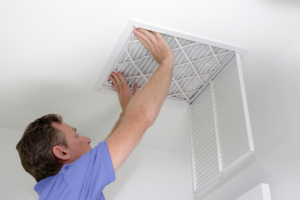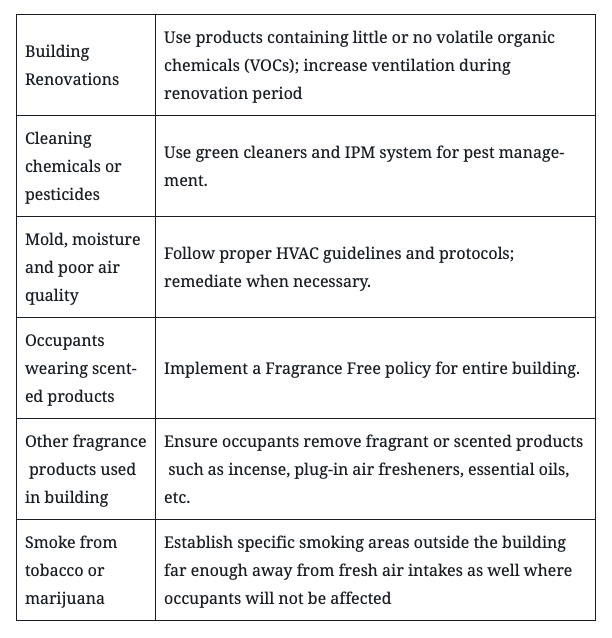Ultimately, the goal of having good indoor air quality is that everyone can equally work and play in an indoor environment without any adverse effects.

Here in Canada, this often overlooked segment of daily life is promoted through the Canadian Committee on Indoor Air Quality (CCIAQ). According to their website, “the objective of the CCIAQ is, ultimately, to improve indoor air quality for all Canadians in every type of building”.
Recently, there have been efforts to raise public awareness about the increasing number of people with chemical sensitivities, often seen through signage such as “This is a Fragrance Free Area”, for example. For further reference, and to see examples of what a Scent Free Policy consists of, the CCIAQ provides a comprehensive guide entitled Module 13 Addressing Chemical Sensitivities , available for download on this website.
The emergence and rise of chemical sensitivities is generally agreed to be a direct result of the increased use and exposure to chemicals and scents in our environment. In an indoor setting, this can become an even more pronounced issue as levels of these potential contaminants can build up. Often times the levels of irritants found inside can be significantly higher than outside, if proper ventilation and air exchange systems are not in place.
Chemical sensitivity varies greatly, from those people who are only mildly affected to those people who have more serious conditions, like Multiple Chemical Sensitivities (MCS), which is considered by the Canadian Human Rights Commission to be a disability.
So, what are some of the most common symptoms of chemical sensitivities?
They range from mild to life-threatening and include:
- Dizziness
- Nausea
- Headaches
- Fatigue
- Runny nose & Itchy eyes
- Trouble concentrating
- Muscle & Joint Pain
- Difficulty Breathing
- Irregular Heartbeat
- Seizures
In order to address the issue of chemical sensitivities in relation to indoor air quality, one should first identify the main factors involved and then consider alternative solutions.
We can broadly categorize these as:
- The physical building
- The occupants
- The Physical Building
When one thinks about chemical sensitivities, what usually comes to top of mind is fragrances. One may wonder then how the physical building could have any impact on chemical sensitivities? Both the building structure itself and how that building is managed are equally important in relation to good air quality and the susceptibility of exposure to chemicals .
The physical building could actually be the source of many contaminants which may not initially be considered. Building finishes such as carpets, office furniture, paint, and fittings may be off gassing, unbeknownst to the building owner or manager. Cleaning and pest management products may contribute to the overall level of triggering compounds as their vapor or residues may contain substances that trigger reactions in those with chemical sensitivities.
If renovations are underway, then the building materials being used, the gas or diesel powered equipment on site, or the paint could be contributing to an increased level of triggering compounds. The building’s HVAC system should be adequate for the size and type of the building and needs to be properly maintained and managed by trained personnel. Mold and excessive moisture levels should be prevented from developing.
2. The Occupants
Whether the occupants are occasional visitors or those who occupy the building on a more permanent basis, everyone who enters is affected by and/or contributes to the indoor air quality.
Most people wear some type of scented or fragrant product, which is often a trigger for those with chemical sensitivities, such as shampoo, deodorant, perfume, cologne and other personal care products. Other strongly scented products used by occupants including plug-in or spray air fresheners, incense, candles and essential oils are also potential contributors to the problem.
Although smoking is now prohibited inside almost every building, smokers often carry the scent on their clothes, or smoke in areas outside buildings close to doorways or windows, either of which may allow smoke or smoking by-products to enter the building.
Issue Alternatives

In conclusion, one can clearly see how intertwined chemical sensitivities are with indoor air quality.
By taking a cooperative and systematic approach to the issue, both building managers and occupants should be able to work together to promote good air quality and optimum health for everyone.
For more in-depth details on the sources and effects of scents, as well as advice for building managers on how to move towards a scent-free building, please refer to the CCIAQ Guide for Indoor Air Quality – specifically Module 6 on Scent-Free Buildings as well as Module 13 on Addressing Chemical Sensitivities.
